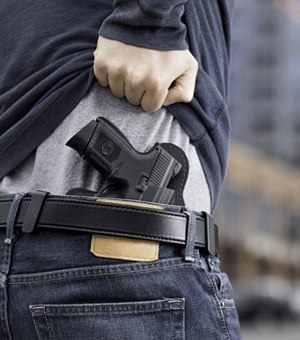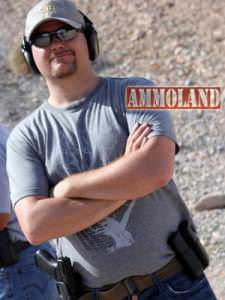
Scott Polk [via Ammoland.com] writes:
Concealed carry is a hot topic among gun people. Minimum acceptable caliber, recommended gun size and model, best holster type, appropriate self-defense tactics, the need for a back-up gun or spare magazines - it's all up for discussion. A new shooter can find this debate - and the resulting advice - confusing. In fact, there are a lot of concealed carry myths that are repeated endlessly by the firearms fraternity. They need calling out; these ideas put people’s lives risk. Here are my top six call-outs in no particular order . . .
1 – You Can’t Carry A Full Size Gun
Many "experts" will say you can’t concealed carry a full-size firearm. It's just too heavy and cumbersome. You'll eventually give up and end-up carrying nothing. You need to carry a compact or pocket pistol! The truth is you can carry whatever size gun you are comfortable carrying that you can conceal effectively. That might be a full size 1911 or a pocket 380.
Your choice depends on a number of variables, including your hand size, your preferred gun type (revolver or semi-automatic) and caliber, the kind of holster you use, your job, your wardrobe and the weather. All of these factors can change depending on the day and the season. Which means you might want a range of concealed carry firearms.
[I have three carry guns. In the summer, I carry a 380 Ruger LCP in my pocket with a remora holster. In fall and spring I move to a Sig P938 in 9mm in an Alien Gear IWB Cloak Tuck 2. In winter I carry my beloved HK Full Size USP 40 or my Springfield Range Officer 1911.]
2 – You Shouldn’t Carry a .380
Many gun people claim that the .380 caliber round doesn’t have enough "stopping power" to be effective. The thing to keep in mind . . .
Defensive shooting is about more than stopping power. As over at Personal Defense Network points out, defensive shooting is a blend of stopping power, accuracy and speed. The .380 will recoil less and allow you to get faster more accurate groupings then the same size pistol in 9mm.
There is absolutely nothing wrong with .380 as a defensive round - especially when you consider the fact that most defensive gun uses end without a shot being fired. Small, soft-shooting .380s are easy to carry concealed. Do not discount them.
3 – You Don't Need To Carry All The Time
Sometimes it seems like a lot of work to put your firearm on to run to the corner shop to get milk. The truth is you never know in advance when you'll need your firearm. Bad things happen in good neighborhoods, in corner shops just like yours. They happen to people on the way to and from work and even in their own homes.
Unless you have psychic abilities you can never truly know when your firearm might be needed. Carry it with you at all times.
4 – You Don’t Need To Carry With A Round In The Chamber
Many people don’t carry their concealed carry firearm with a round in the chamber. They're uncomfortable with the idea that the gun is ready to shoot. It might "go off" accidentally. They believe they'll have time to rack the slide in the event they need to use their firearm.
The unfortunate truth: you may not have the "extra" seconds you need to rack the slide in a defensive gun use. Most gunfights follow the three - three - three pattern: three feet, three seconds, three shots. If you "waste" a second racking your gun, an attacker could be right on top of you, preventing you from firing at all. Not having a round in the chamber could be the difference between life and death.
Carrying a round in the chamber is perfectly safe as long as you are using the correct holster for your gun and you follow all safety rules.
5 – A Concealed Carry Permit Is All You Need To Carry Effectively
Some people believe concealed carry permit training makes them “trained” to use a firearm in a defensive situation. Nothing could be further from the truth. Most concealed carry permit classes don’t even provide a basic firearm competency test, much less prepare you for a defensive situation.
To be as prepared as possible to use your firearm during a life-threatening event, you need additional and ongoing defensive training.
6 – You Don’t Need A Spare Magazine
This is most often said by people who carry a firearm that has a large capacity however many who carry a smaller capacity firearm also carry without an extra magazine. Carrying an extra magazine is not only about having more bullets, it’s also about having the spare magazine in the case of an issue with the first. In the heat of the moment in a defensive situation you don’t want to be stuck with no options.
Often the fastest thing to do in the case of a gun not working properly is to change the magazine which may help to resolve the issue and save your life.
--------------------

About Scott Polk
Scott Polk is a contributor to AmmoLand Shooting Sports News and active in the Great State of Idaho for gun rights.
He supports constitutional carry for everyone. He currently, works with local grass-roots organizations to educate and assist with messaging.
In addition Scott Polk is a pro-gun/second amendment business owner that specializes in internet marketing.
- Twitter: https://twitter.com/scottpolk
- Facebook: https://www.facebook.com/scottpolk


